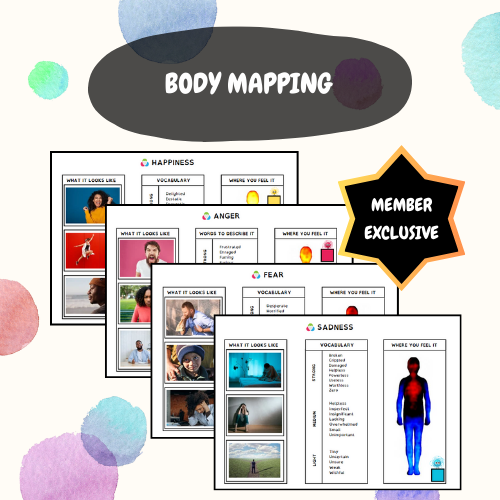Welcome to the Body Mapping Pack
The Emotion Body Map Activity pack is grounded in extensive research exploring the intricate connection between emotions and bodily sensations, known as “where people feel emotions in their body”.
This resource aims to seamlessly integrate external emotional expressions with internal sensory experiences, enhancing the ability to articulate these sensations through powerful language that reflects varying levels of emotional intensity.
Research Insights
Conducted with a diverse sample of 701 participants, the studies involved exposing individuals to a range of emotional stimuli including words, stories, movies, and facial expressions. Participants were asked to identify specific areas of their bodies that experienced heightened or diminished activity in response to each stimulus. Across multiple experiments, distinct patterns of bodily sensations consistently corresponded to different emotional states. Notably, these patterns were consistent among both Western European and East Asian participants, highlighting a potentially universal aspect of how emotions manifest physically. Statistical analyses underscored the efficacy of these bodily sensation patterns in accurately distinguishing between emotions, underscoring the critical role of bodily changes in emotional experiences.
Practical Application
This Emotion Body Map Activity pack translates these research findings into practical tools for educators, therapists, and individuals seeking to deepen their emotional awareness and expression. By using these resources, individuals can develop a clearer understanding of how emotions are physically felt and expressed, fostering better emotional regulation and communication skills.
- More information on the body map images can be found here
This pack contains:
The pack contains mats for different emotions, showing
- What it Looks Like (photograph images of emotions)
- Light, Medium, and Strong Vocabulary of Emotions
- Emotion Images of where you Feel it (linked to the research paper)
- Emotion Body Maps include:
- Happiness
- Anger
- Fear
- Sadness
- Emotion Body Images for: Sadness, Anxiety, Love, Anger, Fear, Happiness (linked to above research)
Pack information
- Number of Pages: 8
- Font: Open Dyslexic
- Format: High Quality PDF File
Members
This is exclusive and FREE TO MEMBERS.
Want to know more about membership benefits? 👉 Click here








